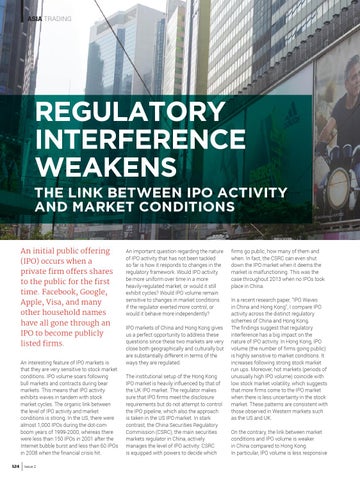ASIA TRADING
REGULATORY INTERFERENCE WEAKENS THE LINK BETWEEN IPO ACTIVITY AND MARKET CONDITIONS An initial public offering (IPO) occurs when a private firm offers shares to the public for the first time. Facebook, Google, Apple, Visa, and many other household names have all gone through an IPO to become publicly listed firms. An interesting feature of IPO markets is that they are very sensitive to stock market conditions. IPO volume soars following bull markets and contracts during bear markets. This means that IPO activity exhibits waves in tandem with stock market cycles. The organic link between the level of IPO activity and market conditions is strong. In the US, there were almost 1,000 IPOs during the dot-com boom years of 1999-2000, whereas there were less than 150 IPOs in 2001 after the Internet bubble burst and less than 60 IPOs in 2008 when the financial crisis hit. 124
Issue 2
An important question regarding the nature of IPO activity that has not been tackled so far is how it responds to changes in the regulatory framework. Would IPO activity be more uniform over time in a more heavily-regulated market, or would it still exhibit cycles? Would IPO volume remain sensitive to changes in market conditions if the regulator exerted more control, or would it behave more independently? IPO markets of China and Hong Kong gives us a perfect opportunity to address these questions since these two markets are very close both geographically and culturally but are substantially different in terms of the ways they are regulated. The institutional setup of the Hong Kong IPO market is heavily influenced by that of the UK IPO market. The regulator makes sure that IPO firms meet the disclosure requirements but do not attempt to control the IPO pipeline, which also the approach is taken in the US IPO market. In stark contrast, the China Securities Regulatory Commission (CSRC), the main securities markets regulator in China, actively manages the level of IPO activity. CSRC is equipped with powers to decide which
firms go public, how many of them and when. In fact, the CSRC can even shut down the IPO market when it deems the market is malfunctioning. This was the case throughout 2013 when no IPOs took place in China. In a recent research paper, “IPO Waves in China and Hong Kong�, I compare IPO activity across the distinct regulatory schemes of China and Hong Kong. The findings suggest that regulatory interference has a big impact on the nature of IPO activity. In Hong Kong, IPO volume (the number of firms going public) is highly sensitive to market conditions. It increases following strong stock market run ups. Moreover, hot markets (periods of unusually high IPO volume) coincide with low stock market volatility, which suggests that more firms come to the IPO market when there is less uncertainty in the stock market. These patterns are consistent with those observed in Western markets such as the US and UK. On the contrary, the link between market conditions and IPO volume is weaker in China compared to Hong Kong. In particular, IPO volume is less responsive
